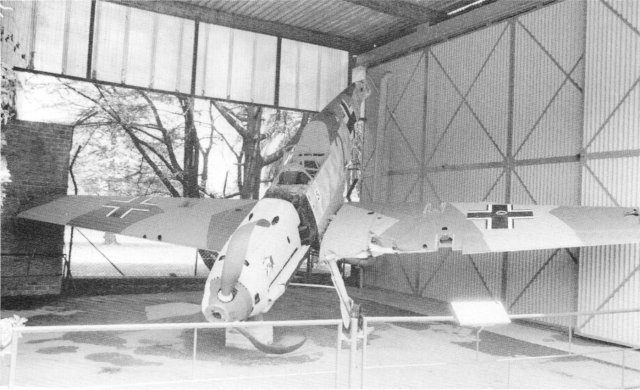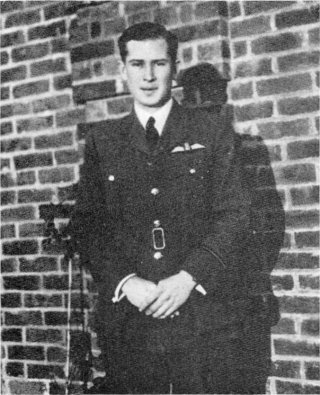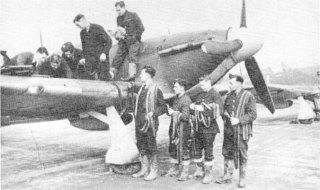

 The South African
The South African
(incorporating Museum Review)
by A Speir
Throughout the Battle of Britain in 1940, Messerschmitt Bf 109E3 (Werknummer 1289) was on the strength of JG26, the fighter group then under the command of Oberstleutnant Adolf Galland which formed part of the regular escorts provided by the Luftwaffe for its daytime bomber strikes on Britain. Generations of South Africans who have visited the South African National Museum of Military History since its opening in 1947 have become familiar with Messerschmitt 1289 as it stands guard at the entrance to the Brink Hall in a simulated crashed position.

The museum's Messerschmitt BF109E3 which formed part of the patrol
which attacked Pat Wells and his squadron on 28 November 1940.
[National Museum of Military History]
On 28 November 1940, Messerschmitt 1289, flown by Unteroffizier Heinz Wolf, formed part of a patrol under the direct command of the Geschwader Kommodore himself that crossed the coast of Sussex where it was engaged by the Hurricanes of No 249 Squadron. In the ensuing dog-fight, Unteroffizier Wolf apparently became separated from the rest of the formation and, finding himself without sufficient fuel for the return journey to France, made a wheels-up forced landing on a farm at Udimore in Sussex where he was taken prisoner of war. Later his aircraft was sent to South Africa for exhibitions of captured enemy equipment and finally became one of the very first exhibits donated to the embryo War Museum.
There used to be an old saying in England 'If you're going to get knocked down by a car, you'd better make sure it's a Rolls-Royce!' Perhaps this might equally apply to fighter pilots - 'If you are going to get shot down, make sure it's by an ace!' In the combat on 28 November 1940, P/0 Wells was unfortunate enough to find himself in the gunsights of Obstlt Galland when he received a considerable amount of both cannon shells and machine gun bullets before his Hurricane burst into flames. Becoming the 56th victim of this famous Luftwaffe pilot, P/0 Wells suffered severe burns before bailing out of his aircraft, but recovered to resume a long career in both combat and, after the war, as a demonstration pilot/salesman of civilian aircraft. This incident of war began a lifelong friendship which still continues between these two pilots.
Squadron Leader P H V Wells, DSO, now lives in peaceful retirement in Constantia, but his story brings a personal South African connection to an aircraft which has been a feature of the SA National Museum of Military History ever since its inauguration 45 years ago. His own account of this memorable day follows:
'RAF fighter pilots at that stage of the war were united in the cry "the 109s are always above us". They usually were, but, in retrospect, I think we missed a lot of them below us, because all eyes were focussed on the sun and the sky above us, hence the development of the "WEAVER".
The position of the "WEAVER" meant that you flew some 1 000 feet (305 m) above the squadron and gave warning of an attack or threatening enemy fighters above. Obviously, through weaving above the others, you used higher throttle settings and thus more fuel to add to your wornes. It was, in any case, a suicidal position - they all went for you first! As a result, only experienced pilots with good eyes were used - unfortunately, I fitted both requirements!
It was a bright autumn afternoon and there was a lot of enemy activity over Kent, so we were wide awake, me in particular, through previous clashes with 109s. Half-way through the patrol at 23 000 feet (7 010 m), I was watching some 109s, some in the sun, but at the time they posed no threat to us and I guessed that the other pilots had seen them anyway so there was no need to alarm anybody.
The next thing I knew was an attack from below. I took evasive action and howled on the R/T (radio) but nobody heard me nor saw the attack which was a lethal one. I was able to take some evasive action until my controls were shot away. This may explain why General (then Lt-Gen) Adolf Galland's combat report shows that he used 132 machine gun rounds and 64 cannon shells on me! My Hurricane was well alight but I could see "tracer" bullets going over the left wing and hear bullets rattling against the armour-plate at the back of my seat so there was no point in baling out into that lot and I sat and fried. He eventually left me diving vertically and his combat report quotes: "Fate of enemy pilot - DEAD BY BURNING."
One gets dopey from flames, smoke, fumes and lack of oxygen, so my first attempt to get out was a failure - my right foot got caught under the instrument panel. I climbed back in and tried again, but this time my left foot got caught. A Hurricane diving vertically and on fire is not easy to exit! As I had earlier seen the sufferings of burned pilots in hospitals, I decided that I did not want to be burned so I decided "to hell with this - I will go in with the aeroplane".
A lot closer to the ground than I would normally have chosen, I was miraculously thrown out of the cockpit. To prove its reluctance to lose me and because of its vertical state, the tail of the aircraft hit me and dislocated my left shoulder. However, I still had my right hand to pull the ripcord and this I did. Sheets of skin were hanging from my face and legs and the cold really stung the open nerve ends. I could smell roast pork for weeks afterwards! I landed in an apple-tree which was prickly without its leaves, adding to my discomfort when falling through it.

Pat Wells as he appeared in 1940 before his encounter with
Adolf Gatland
[Photo: Pat Wells]

North Weald RAF Station, 1940. A Hurricane of 249 Squadron
being rearmed.
[Photo: Pat Wells]
I was taken to Leeds Castle Emergency Hospital, near Maidstaone in Kent, where I spent a week. All burned pilots were required to be taken to Queen Victoria Hospital at East Grinstead where Archie Mclndoe did marvellous work on his "guinea pigs". I made a good recovery - so good, in fact, that the RAF, being short of pilots, had me back flying operationally on 24 February 1941 with the same squadron from the same RAF Station.
I had met JG26 often before - you could not mistake their yellow noses and the formidable bunch that they were. I met one of them, Oberleutnant Joachim Mflncheburg, in Malta, where he put a cannon shell through my right ankle. He was finally killed in Tunisia with a score of 135. Adolf Galland told me that he was one of his best proteges, but that is another story.'
PAT WELLS
Constantia, 1993.
Return to Journal Index OR Society's Home page